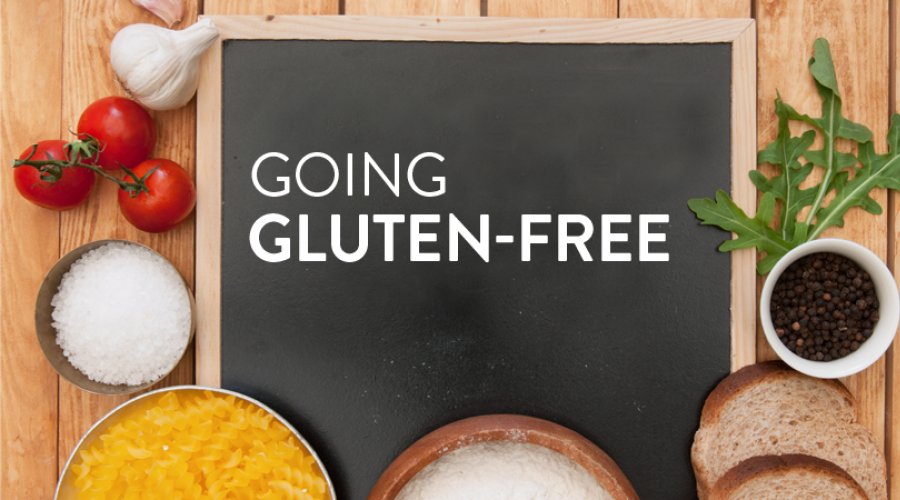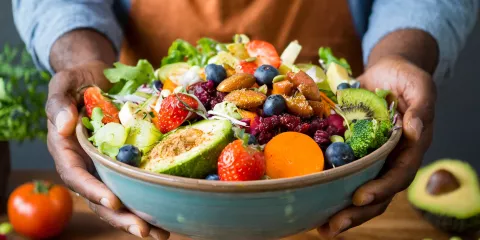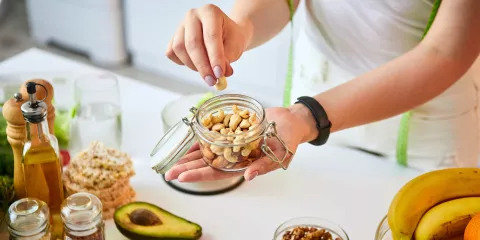
Does getting invited to a bagel breakfast put you in panic mode? Have you taken to subbing in spaghetti squash for pasta with Sunday dinners? This is a reality for so many who have decided they need to avoid gluten at all costs - even if it means turning down that slice of pizza.
But what exactly is gluten and why are so many people trying to cut it out of their diets? Gluten, a small protein composite that helps dough rise and gives it a chewy texture, is found in wheat, barley, rye and other grains. Gluten, as vital wheat gluten in seitan, is a source of protein for vegans and vegetarians.
There are two groups of people that do need to avoid gluten - those with Celiac Disease and those with Non-Celiac Gluten Sensitivity.
What is Celiac Disease?
According to the Celiac Disease Foundation, Celiac disease is a serious autoimmune disease that is estimated to affect in 1 in 100 people worldwide and nearly 2.5 million Americans are thought to be undiagnosed.1 When someone with Celiac disease ingests gluten it causes an immune response that damages the small intestine and interferes with the absorption of nutrients. Symptoms of celiac disease include: bloating, chronic diarrhea, constipation, gas, lactose intolerant, nausea, vomiting, and abdominal pain. Symptoms may also occur in other parts of the body that could seem unrelated such as fatigue, joint or bone pain, depression, anxiety, reproductive issues and oral issues such as canker sores or dry mouth.2 The only treatment available is going gluten-free completely.
What is Non-Celiac Gluten Sensitivity (NCGS)?
There are some people who have been tested for Celiac disease and the results are negative. Yet, their symptoms are the same - they have the same stomach issues, the anxiety, the fatigue, the headaches. So what could be the cause? In the absence of another diagnosis, these people may be told they have Non-Celiac Gluten Sensitivity (NCGS). Because there are no markers to test for, NCGS is less well defined and the cause may actually be other components and not simply the gluten causing the issues.3 The symptoms can also be similar to other GI disorders such as IBS. A high percentage of patients with NCGS who followed a gluten-free diet still experience symptoms years later, so a definite diagnosis is difficult to determine.4
What About Everyone Else?
So if these are the two groups who need to stay away from gluten - a fairly small percentage of the population, then why are the shelves filled with everything from gluten-free cookies to gluten-free skincare products? Why do people go gluten-free?
Much like the keto diet, going plant-based, or even the Atkins diet that was all the rage in the 90s - ways of eating become trendy. They become healthy buzzwords and soon everyone thinks they need to follow suit. With that, companies see dollar signs and have created an entire market to cater to those who think that gluten-free is the way to go. In fact, the gluten-free market in 2019 was estimated to be $21.61 billion USD and is expected to grow 9.2% annually through 2027.5
Read More: What’s Missing From Your Diet?
- Gluten-free doesn’t necessarily mean something is healthier. Gluten-free cookies are still cookies and may contain lots of sugar, seed oils, artificial sweeteners, and other undesirable ingredients. The same can be said for gluten-free chips, bagels, pasta, etc. In fact, substituting these for their whole-grain counterparts may actually lead to weight gain in some individuals who fail to read the nutrition facts label. It shouldn’t be assumed that a gluten-free label equates to a healthy alternative.
- Gluten-free replacement foods such as gluten-free breads and baked goods contain acellular carbohydrates. These contain incomplete cells and have a higher carbohydrate density. Higher carb concentrations from gluten-free flours, processed foods, and sugars may contribute to systemic inflammation and negatively affect the microbiome.6
- When cutting gluten, many cut carbs entirely and may be missing out on the essential nutrients that are found in whole grains. Gluten-free replacements are often made with refined grains and devoid of the nutritional benefits we obtain from a diet rich in whole grains. Whole grains contain B vitamins, antioxidants, and trace minerals such as iron, zinc, copper, and magnesium. They are also a good source of fiber which promotes elimination and colon health.7
- When we remove carbs from our diets, they are often replaced with sugar and fats. While the benefits to a diet rich in healthy fats such as olive oil, nuts, salmon, and avocado are many, there are many unhealthy fats that might be consumed in the quest to feel satiated. This may increase cardiovascular risks, inflammation and diabetes.
Mixed Signals…
But there are two sides to every story. While the mainstream narrative does focus on the benefits of whole grains and the downside of a gluten-free diet for those without Celiac disease or NCGS, there is a growing body of evidence that says there is no downside to removing it. In fact, some claim everyone should remove gluten due to its effects in the body. A study published in Nutrients in 2015, showed increased intestinal permeability (aka “leaky gut”) in all individuals, even the non-celiac controlled group when exposed to Gliadin, one of the proteins found in gluten.8 Leaky gut, while not yet clearly embraced by the medical community, is thought to happen when the tight junctions in our intestinal lining don’t close properly. This allows substances to “leak” through and enter our tissues. Symptoms of leaky gut are gas, bloating, fatigue, joint pain etc and mimic other conditions such as Crohns, IBS and even Celiac disease. Much more research needs to be done on this topic.
What’s The Verdict?
Unfortunately, the jury is still out on this one. If you suspect you have Celiac disease or a gluten sensitivity, the best course of action is to talk with your healthcare provider. If you have ruled it out but are still experiencing symptoms such as digestive distress, brain fog or fatigue, it can’t hurt to try life without it for a bit and see how you feel.
If you do decide to cut out the gluten, be mindful of nutrition labels and minimize substitutes such as gluten-free treats. Look to fill your diet with lots of fresh fruits, veggies, and proteins to be sure you are getting the essential nutrients that would otherwise come from whole grains. Also, be sure to include non-gluten grains such as quinoa, brown rice, millet, amaranth and gluten-free oats.
Whatever you decide, just remember that everyone is different. Just because your friend says that going gluten-free was great for them, doesn’t mean you have to give up your Friday night pizza just yet! It is so important to listen to your body, pay attention to your symptoms and know when it is time to talk to your doctor or other trusted healthcare professional.
References
1 What is Celiac Disease? Retrieved from: https://celiac.org/about-celiac-disease/what-is-celiac-disease/
2 Symptoms & Causes of Celiac Disease. October 2020. Retrieved from: https://www.niddk.nih.gov/health-information/digestive-diseases/celiac-disease/symptoms-causes
3 Barbaro, M. R., Cremon, C., Stanghellini, V., & Barbara, G. (2018). Recent advances in understanding non-celiac gluten sensitivity. F1000Research, 7, F1000 Faculty Rev-1631. https://doi.org/10.12688/f1000research.15849.1
4 Tovoli F, Granito A, Negrini G, Guidetti E, Faggiano C, Bolondi L. Long term effects of gluten-free diet in non-celiac wheat sensitivity. Clin Nutr. 2019 Feb;38(1):357-363. doi: 10.1016/j.clnu.2017.12.017. Epub 2017 Dec 26. PMID: 29306516.
5 Gluten-Free Products Market Size, Share & Trends Analysis Report By Product (Bakery Products, Dairy/Dairy Alternatives), By Distribution Channel (Grocery Stores, Mass Merchandiser), By Region, And Segment Forecasts, 2020 - 2027. February 2020. Retrieved from: https://www.grandviewresearch.com/industry-analysis/gluten-free-products-market
6 Kresser, C. Carbohydrates: Why Quality Trumps Quantity. May 2019. Retrieved from: https://chriskresser.com/how-to-avoid-negative-side-effects-of-a-gluten-free-diet-and-make-the-most-of-your-diet/
7 Zelman, K. Tips for Reaping the Benefits of Whole Grains. June 2011. https://www.webmd.com/food-recipes/features/reap-the-benefits-of-whole-grains
8 Hollon J, Puppa EL, Greenwald B, Goldberg E, Guerrerio A, Fasano A. Effect of gliadin on permeability of intestinal biopsy explants from celiac disease patients and patients with non-celiac gluten sensitivity. Nutrients. 2015 Feb 27;7(3):1565-76. doi: 10.3390/nu7031565. PMID: 25734566; PMCID: PMC4377866.












